|
| |
|
HOME
Background music "Mekong" courtesy of Roger Clyne and the Peacemakers. For more details, click on the above link to SOURCES and NOTES. BACKGROUND MUSIC CONTROLS |
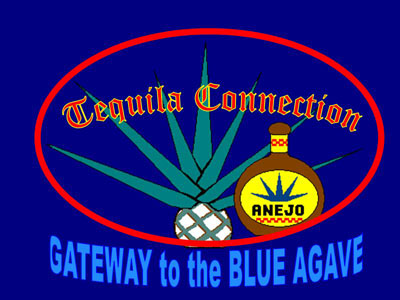
|
|
TEQUILA PRODUCTION 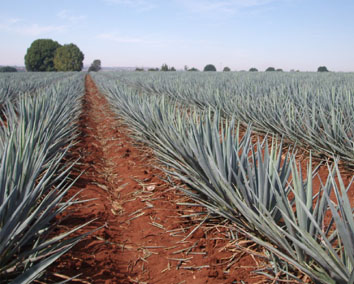
In the region of Jalisco around the town of Arandas (known as the
highlands) the soil is very volcanic in composition. The heavy concentration of minerals gives the soil a reddish tint. The Agave tequilana A. Weber species (Weber Blue Agave) thrives in this region. The ecosystem absorbs water when it rains thus no irrigation is necessary to farm the agave plants. During visits to El Arenal, Amatitan, Tequila, Atotnilco, Jesus Maria and Arandas (2009-2022), Tequila Connection toured dozens of tequila distilleries and observed many variances in production processes used across the industry. 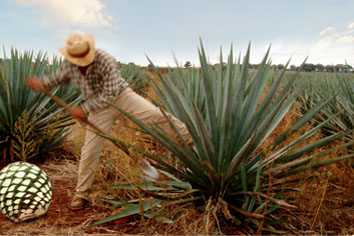
A skilled jimador can harvest over 900 kilos of piñas daily, loading and hauling them by truck to the factory where they are cut into halves or quarters for baking. 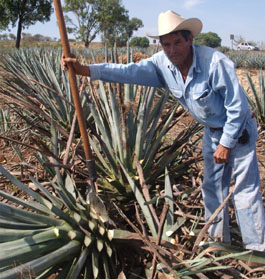
As a quick overview, mainly, there are three different methods being used today to produce tequila. #1, There is the "Artesanal Process" whereby the cooked agave is crushed by a large stone wheel (called a "tahona") pulled by horse, mule or ox. This process is characterized by the use of stone-lined cooking ovens, wooden fermentation tanks, and steam copper pot stills. #2, is a more modern process where the cooked agave is crushed by mechanical roller shredding mills and presses. During the shredding process, the fibers are washed with water to help extract the sugars. This process is characterized by the use of stainless steal autoclaves, stainless fermentation tanks, and stainless pot stills. And #3, the "Diffuser Process" whereby uncooked piñas are fed through mechanical shredders to break down the fibers. This involves raw extraction of the carbohydrates of the previously shredded piñas and their dilution in water, with the help of a diffuser. The product is then fed through an in-line cooker.[35] This process is characterized by the use of column stills. Within each process there are additional variances, combinations and exceptions used by the manufacturers (which helps define the quality of the final product). There is also an older "ancestral" method that has been abandoned over time, but has been brought back to some degree by some producers looking to achieve profile characteristics lost by process modernazation. More about that later. Of the distilleries I visited, method #2 was by far the most common process being used. In the following description of the manufacturing process, I will insert some of the variances I observed during my visits to tequila distilleries. 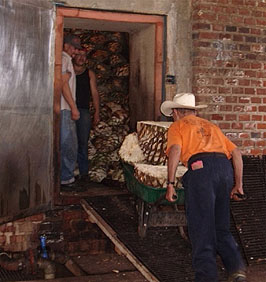
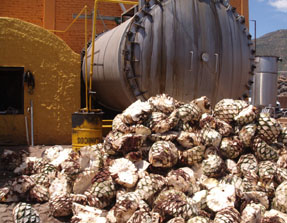
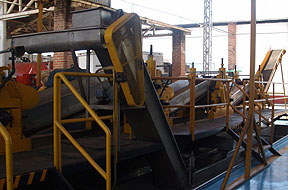
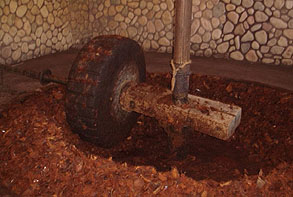
The mosto is transferred to large fermentation vats. Yeast is added to accelerate the process of converting the sugars into alcohol. Each company keeps their own yeast a tight secret.[35] 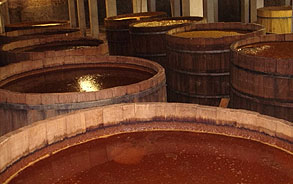
The time required to complete fermentation (about 3-10 days) depends on the environment. It will take longer in the winter when temperatures are lower. Some manufacturers will accelerate yeast growth by adding chemicals resulting in less body. Some manufacturers speed fermentation by using cane or brown sugar cones (piloncillo) allowing them to produce more product with fewer or less mature plants. This type of tequila (called mixto) can be bottled anywhere or sold in bulk to other countries with less stringent regulations regarding agave content. If the label does not state 100% agave, the bottle likely contains mixto tequila. 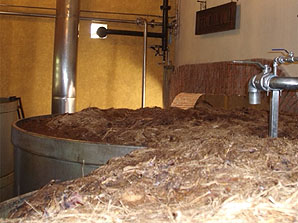
I observed another interesting variation at the old Siete Leguas factory in Atotonilco. They transfer the mosto along with the tahona-crushed agave fibers to their fermentation tanks. Siete Leguas believes keeping the fibers with the mosto during fermentation and the first distillation enhances the agave flavor. Siete Leguas blends tequila produced at their old factory with tequila produced at their new factory to achieve the desired flavor profile. 
The times required for each distillation vary between manufacturers. In one factory the first distillation takes about 1½ to 2 hours and produces about 20% alcohol content. The second distillation takes 3 to 4 hours and yields about 55% alcohol content. Yet for another producer, the first distillation takes 3 hours yielding 20-25% alcohol and the second distillation takes 6 hours to achieve a 55% alcohol content. 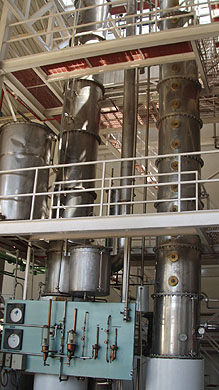
Upon completion of the first distillation, the product is called "Ordinario". After the second distillation, the product is called "Tequila". At this point the tequila normally has an alcohol content of 55% or higher. 55% alcohol is the equivalent of 110 proof. The product is then diluted with distilled water to reach the desired level of alcohol (normally 38 - 40%). Many manufactures use 38% alcohol content for tequila being sold in Mexico, and 40 % for tequila being exported to the United States (as this is believed to be preferred by the respective markets). Occasionally, a manufacturer may use a triple-distillation process. Two examples are Corzo Tequila and Casa Noble Tequila. Triple-distillation (or more) does not necessarily result in a superior product compared to other brands made from double-distillation. It is however another variation to the process used by some manufactures to further refine their product. At this point, the tequila can be bottled as a blanco, silver, or plata, or it may be left to settle in stainless-steel tanks prior to bottling. Alternatively, it can be rested (aged) in wooden barrels (to be sold as a reposado, añejo, or extra añejo tequila). Aging develops color, body, aroma and incomparable taste. The blanco can also be blended with an aged tequila (then labeled as a Joven tequila.) 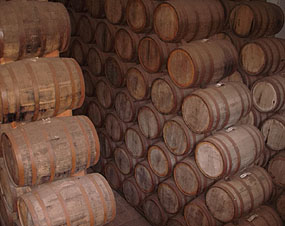
Reposado may be rested in barrels or casks as large as 20,000 liters, allowing for richer and more complex flavors. The preferred oak comes from US, France or Canada, and while they are usually white oak, some companies choose to char the wood for a smoky flavor, or use barrels that were previously used to hold a different kind of alcohol ( i.e. whiskey, scotch, cognac or wine). Some tequilas are aged in new wood barrels to achieve the same effects in less time.[18] Añejos are sometimes rested in barrels that have been previously used to rest reposados. The barrels cannot be more than 600 liters, although most are stored in barrels of about 200 liters. Many of the barrels used are from whiskey or bourbon distilleries in America (such as Jack Daniels). French and Canadian barrels are also used for aging tequila.[19] Some producers believe after 3-4 years of aging the tequila is at its best, thus the añejo is removed from the wood barrels and placed in stainless steel tanks (to reduce the amount of evaporation that can occur in the barrels) until they are ready to bottle it.[18] 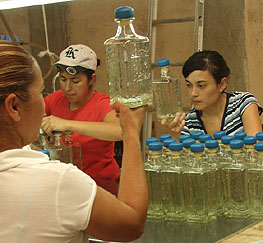
Mexican laws state that tequila can be produced only in the state of Jalisco and limited regions in the states of Guanajuato, Michoacán, Nayarit, and Tamaulipas. The "Apellation of Origin and Quality" is an internationally recognized legal concept. Its most important aim is to avoid the names of some products (which have attained prestige and important recognition) from turning into generic names which can be used at will. Its main goal is to protect the rights of consumers who demand guaranteed high-quality products made under strict conditions and specifications. [2] In 1997, after 10 years of litigation, the European Union and Mexico signed an agreement to protect the exclusiveness of the use of the name Tequila. [33] 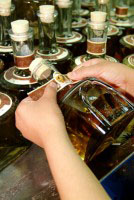
The Consejo Regulador del Tequila (CRT) is responsible to ensure manufactures comply with strict guidelines of the NOM during all phases of the production and marketing process. The CRT visits production sites conducting inspections to ensure compliance. This is Mexico's method to standardize tequila production and ensure authenticity. All 100% agave tequilas must have a NOM identifier on the bottle. To view photos of numerous distilleries we visited, click on the DISTILLERY PHOTO GALLERY section of this website. For information on arranging tours to these distilleries, review the EVENTS page of this website. Another process used long ago, but rarely used to make tequila today, involved cooking the agave piñas in underground pits lined with rock and clay. Similar to how a pig is roasted for a Hawaiian luau, the natives would build a fire in a pit lined with rock and clay. They would let the fire burn down and then place the piñas on ambers and coals. They would then cover the piñas with agave leaves and soil and allow it to bake slowly for several hours. In centuries past, they used below-ground fermentation pits and direct-fired copper stills. The tequila was stored in clay or glass containers with limited use of wooden tanks and barrels. On our more recent visits to the Tequila Valley, we have observed a few producers bringing back some traditions. For example, Cascahuin and Don Valente distilleries have underground cooking capabilities. Speaking for myself (Cary of Tequila Connection), I really like the results and greatly appreciate the efforts of producers using the Ancestral/Artesanal methods. Photos were taken by Cary Hershberger and Gary Egli. Request photos not be reproduced or duplicated without permission from TequilaConnection.com. Two photos (#1 Jimador and Bottle Labeling photo) courtesy of Tequila 1921. | |